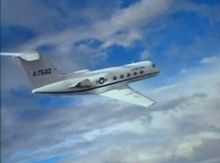The Disappearance of Flight 412
| The Disappearance of Flight 412 | |
|---|---|
 | |
| Directed by | Jud Taylor |
| Produced by | Gerald L. Adler |
| Written by |
George Simpson Neal R. Burger |
| Starring |
Glenn Ford Bradford Dillman David Soul |
| Music by | Morton Stevens |
| Cinematography | Robert B. Hauser |
| Edited by | Carroll Sax |
| Distributed by | NBC |
Release dates |
|
Running time | 72 minutes |
| Country | United States |
| Language | English |
The Disappearance of Flight 412 is a 1974 made-for-television science fiction drama film starring Glenn Ford, Bradford Dillman, David Soul and Guy Stockwell.[1] The film was shown as an NBC World Premiere Movie in 1974.[2]
Plot
U.S. Air Force Colonel Pete Moore (Glenn Ford) is the commander of the Whitney Air Force Base Radar Test Group, which has been experiencing electrical difficulties aboard its aircraft. To find the problem, he sends a four-man crew on Flight 412, with Captain Bishop (David Soul) as commander. Shortly into the test, the Grumman Gulfstream II jet, a small twin-engine VIP transport, picks up three blips on radar. Subsequently, two fighters scramble to investigate and mysteriously disappear.
At this point, Flight 412 is forced to land by Digger Control, a top-level military intelligence group that debunks UFO sightings, diverted to a remote, abandoned military airfield somewhere in the desert in the American Southwest. The crew is taken to a barracks building to undergo an 18-hour debriefing by members of a military Scientific Investigation Division (SID) team, which is more like an indoctrination to convince them that they did not see a UFO. Meanwhile, their aircraft is stored in a dilapidated hangar to hide it from search-and-rescue aircraft. To all appearances, Flight 412 has simply vanished into thin air. Colonel Moore, with the help of Major Mike Dunning (Bradford Dillman), sets out to find out what has happened to his crew.
Just as the government interrogation begins to raise doubts among the flight crew about the "flying saucer" sighting, Moore and Dunning find the secret base. Their efforts to release the crew are stymied by SID leader, Lieutenant Colonel Trottman (Guy Stockwell), who cites national security concerns. Bishop attempts to escape, but Trottman threatens to make things rough on his crew, who agree to accept a sanitized version of their report. After their release, when Dunning and Podryski choose to accept the report, the others: Moore, Bishop, Ferguson and Riggs seek the help of General Enright (Kent Smith). Trottman appears and makes the case to the General that nothing untoward has happened. When a similar incident later occurs, the same process is employed; those who cooperate get promoted, while the others find that their careers suffer.
Cast
As appearing in The Disappearance of Flight 412, (main roles and screen credits identified):[3]
- Glenn Ford as Colonel Pete Moore
- Bradford Dillman as Major Mike Dunning
- David Soul as Captain Roy Bishop
- Robert F. Lyons as Captain Cliff Riggs
- Guy Stockwell as Lieutenant Colonel Trottman
- Greg Mullavey as Lieutenant Tony Podryski
- Kent Smith as General Enright
- Stanley Bennett Clay as 2nd Lieutenant Ferguson (credited as Stanley Clay)
- Jonathan Goldsmith as Smith (credited as Jonathan Lippe)
- Jack Ging as Green
- Ken Kercheval as White

Production
The Disappearance of Flight 412 was shot at Oxnard Air Force Base and Edwards Air Force Base. The film starts out with stock black-and-white clips of UFOs in flight and various individuals reporting sightings in newsreel style, with narrator voice-overs, to set the mood. However, the remainder of the film (in color) deals only briefly with the fictitious UFO encounter by the aircrew, focusing instead on their ordeal as they undergo an arduous debriefing and brainwashing at the hands of their somewhat mysterious captors. It uses on-screen time stamp titles to lend the feeling of a documentary, similar to the 1971 film The Andromeda Strain. [N 1]
Reception
After its broadcast premiere, The Disappearance of Flight 412 was destined for late-night TV and lately, home media release. Later reviews have relegated the film to an also-ran due to its "cheesy" production values with a reliance on stock footage.[5]
References
Notes
- ↑ The use of stock footage of aircraft is problematical. While period accurate U.S. Marine McDonnell Douglas F-4B Phantom II fighters are scrambled, the scene switches to Grumman F9F Panther fighter aircraft sent up as interceptors, an unlikely prospect, considering their retirement in the 1950s.[4]
Citations
- ↑ Chartrand, Harvey. "Bradford Dillman: A Compulsively Watchable Actor". Cinema Retro magazine.
- ↑ Ford 2011, p. 164.
- ↑ "Credits: The Disappearance of Flight 412 (1974)."Turner Classic Movies. Retrieved: September 19, 2013.
- ↑ Decker, Nathan. "The Disappearance of Flight 412 (1974)". millionmonkeytheater.com, March 2008. Retrieved: September 19, 2013.
- ↑ Shatzer, John. "The Disappearance of Flight 412 (1974)". gutmunchers.com, 2008. Retrieved: September 19, 2013.
Bibliography
- Ford, Peter. Glenn Ford: A Life (Wisconsin Film Studies). Madison, Wisconsin: University of Wisconsin Press, 2011. ISBN 978-0-29928-154-0.
- Thomas, Nick. Raised by the Stars: Interviews with 29 Children of Hollywood Actors. Jefferson, North Carolina: McFarland, 2011. ISBN 978-0-7864-6403-6.
External links
- The Disappearance of Flight 412 at the Internet Movie Database
- The Disappearance of Flight 412 is available for free download at the Internet Archive
- The Disappearance of Flight 412 at AllMovie
| ||||||